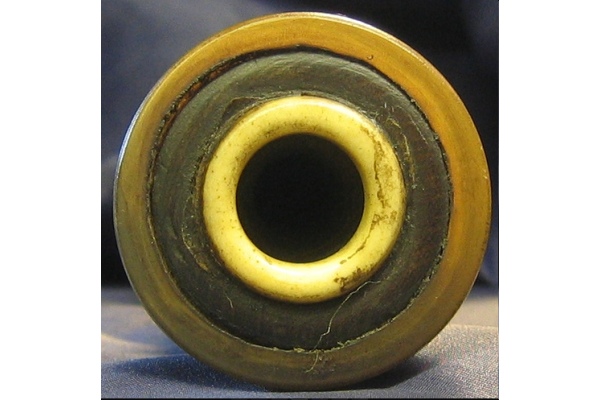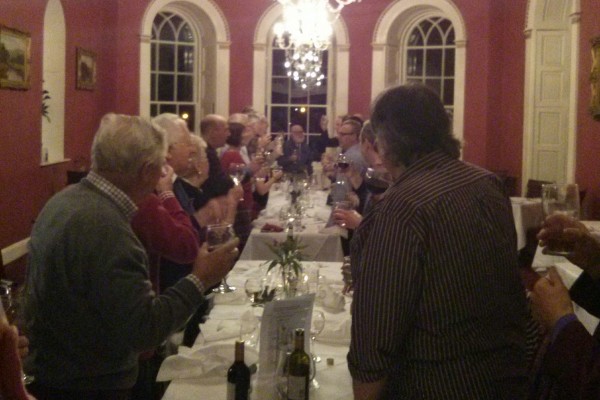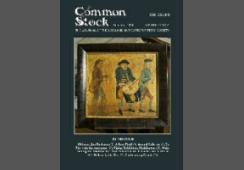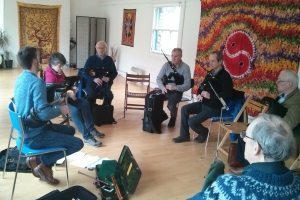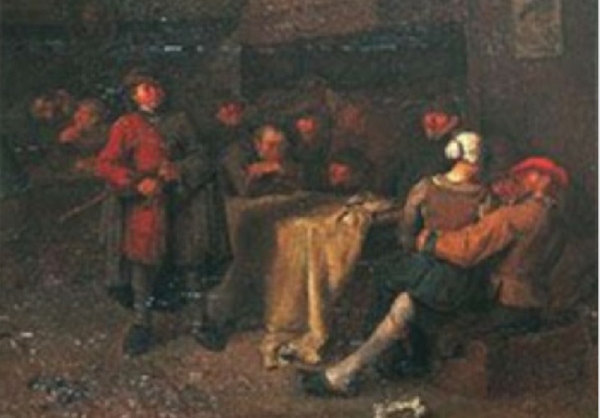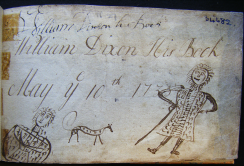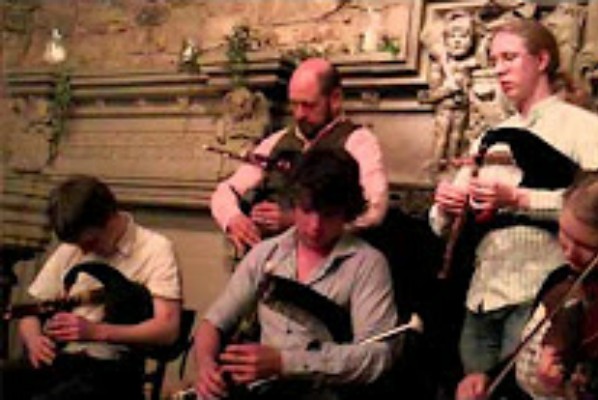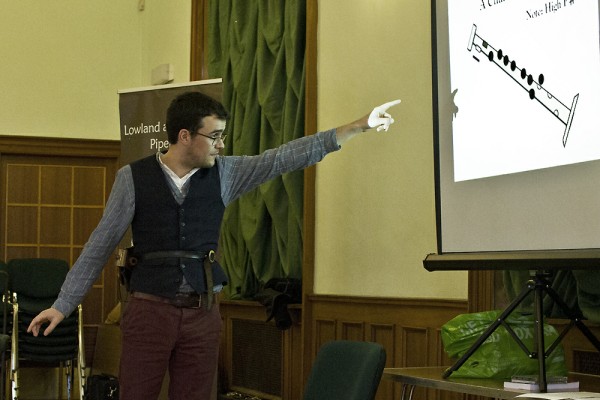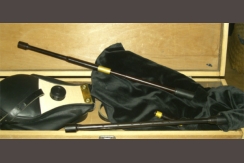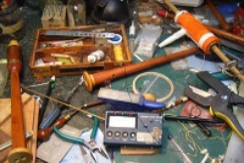To celebrate the fortieth anniversary of the Society, we asked those who were present at that meeting in Edinburgh in 1981 for their memories of the event
These are my recollections of the small get-together in 1981 that would lead to the formation of the Lowland and Border Pipers Society. The Edinburgh Folk Festival was held between the 20th and 29th March 1981. and "featured bagpipe music from Spain, Ireland, Brittany and Northumbria" . Some weeks earlier I received a letter from one Michael Rowan suggesting that the Lowland and Border bagpipes should be revived and that interested parties should meet at Teviot House on Saturday 28th March to that end. At that time I only knew of Robert Wallace and Jimmy Anderson as players of the instrument and I had visited Hugh Cheape at the Scottish National Museum in Queen Street where he had shown me some of the museum collections and we discussed a "lost folk bagpipe tradition in Lowland Scotland."
When I arrived at Teviot House I met Mike Rowan and was swept up in his enthusiasm for the idea of revival of the bellows bagpipes of Scotland. Jim Eaton from Cranshaws in the Borders came to the meeting with an antique set of Lowland bellows pipes; conical bore, two tenor drones, non functioning. I brought my home-made set that I had put together from various sources - it worked and can be heard on my 1983 recording 'Border Reiver' (which I have recently put on my website, https://oddscotland.com/new-page-4).
Hugh Cheape offered access to the museum collection for research and P.M. John MacLellan offered to put a notice about the Society in his magazine International Piper. Mike became Chairman of this new society and I became secretary. I think we went for a drink after the meeting ended.
Following the publication of International Piper I started to get considerable mail from all over Scotland, England and the Scottish diaspora - Australia, Canada, USA, New Zealand and even Argentina; soon we had a mailing list and people willing to pay a subscription. Thereafter we held meetings, one at Mike Rowan's castle in East Kilbride where David Hannay and Ian MacDonald came, one in Linlithgow where Robbie Greensitt and Hamish Moore and David Taylor attended; three that I can remember in the Borders at Thirlestane Castle and Selkirk where Mike Ward, Brian Holton, Paul Roberts, Jim Gilchrist and Hamish Moore attended. The Society continued with these informal meetings until 1983. Then when I was performing at the Edinburgh Festival as part of a series of "folk music" concerts I met Peter Cooke, a lecturer at the Edinburgh University .
Incredibly, it was the first time that British traditional music had been included in the official Edinburgh Festival. Kathryn Tickell also took part in this event. It was after one of the concerts that Peter Cooke invited me to a ceilidh at the Edinburgh Students Union in Chambers Street. There I met the amazing Betsy White - singer /storyteller extraordinaire and wonderful person who was a great inspiration to me. I played my Scottish smallpipes; Colin Ross had made a D chanter that I played with a set of D Northumbrian drones. Peter Cooke had heard about the fledgling LBPS and suggested that we could use the School of Scottish Studies meeting room on Saturdays free of charge. Thereafter most meetings took place there, Jim Gilchrist started Common Stock in 1983 and pipemakers’ order books began to fill up.
Several pipemakers have enjoyed full time careers and produced many thousands of instruments since those early days. Colin Ross modified the Northumbrian chanter to produce the modern Scottish smallpipe and it has been copied all over the world. Nigel Richard successfully developed a conical-bored chanter in concert pitch, enabling playing with other instruments. The other important makers who were present at the beginning of the revival were Hamish Moore, Robbie Greensitt, Julian Goodacre and John Swayne. Most younger makers and players probably have no idea that before 1981 there were probably only three or four working sets of Scottish bellows pipes and no makers.
Mike Rowan also created 'Big Rory' in 1981 and he went on to tour the world bringing fun and laughter to countless thousands and his bringing together of myself and John MacLellan brought about a renaissance of a neglected instrument giving work and pleasure to many more. But an instrument needs music to play on it and there is much more to do on this front to preserve and develop the traditional music for the Lowland and Border pipes.
Gordon Mooney
In the introduction to this year’s online competition, Gordon, who was one of the judges, added this to his memory of that first meeting:
“I was just recalling when Mike Rowan called us to a meeting in Teviot Hall in Edinburgh; four of us showed up - Mike, Jim Eaton, John Mclellan and Hugh Cheape, who at the time was working at what became the Museum of Scotland, and a bundle of sticks, nothing that really worked - and out of that came the Society - I learnt later that at the same time Colin Ross was in the basement of the same building selling his first set of Scottish Smallpipes. So there's a piece of information you didn't know.”
Gordon also sent us the following tune with this comment:
The tune was written the day after the Dunblane shooting of the children and their teacher. Apparently Lammermoor is where Saint Cuthbert as a child had a vision of St Aidan being taken to heaven by angels. Cuthbert’s followers later built a church to commemorate this event and called it Childs Kirk...over the centuries it has become Channelkirk. We recorded two versions of Lammermoor on the album "On the Border". https://gordonmooney.bandcamp.com/album/timeout-of-mind-on-the-border. In USA I have heard it called 'Lawnmower' along with Matt’s 'Linda's Farm'.

Hugh Cheape also sent us his memory of one of the subsequent meetings:
It was at a very informal event in Linlithgow which I remember for its hugely friendly atmosphere - given this was a 'new' gathering of folks who had rarely or never met for a drink before - and a sense of excitement, anticipation and intense interest. We felt strongly enough about the 'cause' that this was more or less when a more-widely shared sense of purpose emerged, and the enthusiasm to take the group forward was there.
I remember vividly the composition of the note in International Piper. Gordon and I used to meet for lunch in the cafe in the City Arts Centre (which was mid-way between our respective offices) and we thought that it would help to formulate some sort of 'statement' - and organise our own thoughts. So we drafted it and I approached John MacLellan to publish it. John and I were on good terms since I had been able to negotiate a prize for Piob. Soc. from a German foundation.
[Ed: The ‘statement’ Hugh refers to is the one reproduced on pages 26 and 27 in this issue, scanned from the original issue held in the Society archive]





The attendees at the first meeting of what was then ‘The Lowland Pipers’ Society’, April 16, 1981.
Mike Rowan (1984);
John MacLellan (c. 1985?. photo courtesy of Bagpipe News
Gordon Mooney (c. 1983?-Playing his aluminium pipes- “it must have been after a pipe band practice” he told us);
Hugh Cheape (1981; photo courtesy of The Scotsman
Jim Eaton
